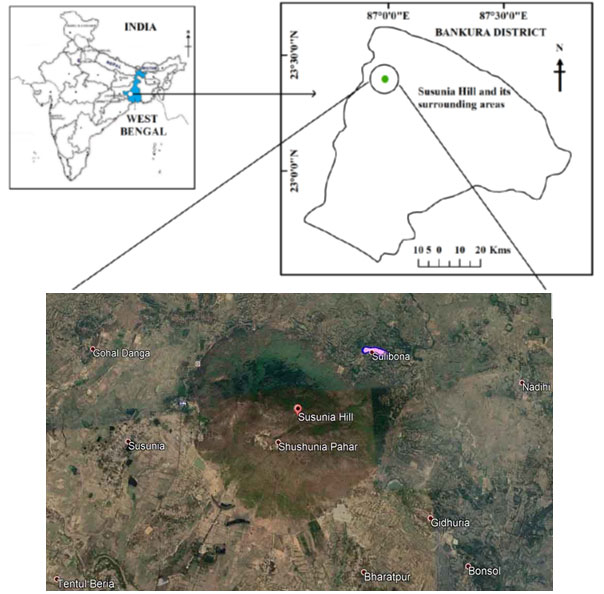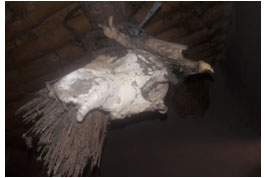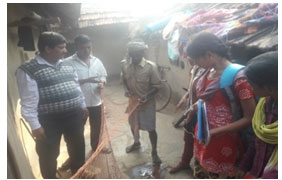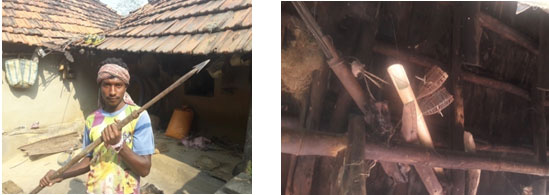Assistant Professor, Department of Zoology, Bankura Sammilani College, Bankura,722012, West Bengal, India
Corresponding author email: rpmondal09@gmail.com
Article Publishing History
Received: 10/07/2020
Accepted After Revision: 15/09/2020
Hunting of wild animals from wilderness for sustenance is the common practice of many tribal communities. Indigenous tribal communities were engaged in hunting for many reasons like food, medicine, trade, culture and leisure. In the present communication an attempt has been made to document the traditional knowledge of tribal people which were inherited from generation to generation among the tribal residing in the villages surrounding Susunia hills. The study was conducted during August, 2019 to December, 2019 covering five villages around Susunia hills of Bankura. The survey, group discussion and data collection method were followed by a standard set of questionnaires. A total of 56 tribal people responded to our queries on different aspects of hunting, information on hunting gears, hunting practices and species targeted for hunting. The information was collected by interviewing aged and knowledgeable tribal people. A total of 36 species of animals were documented which were used by them during wildlife hunting.
Various fossil remains were also collected and documented by Zoological survey of India from the Indian Pleistocene alluvial deposits from the surrounding villages of Susunia hill. It has also been concluded from the study that due to improvement of socio-economic status, betterment of educational and other governmental facilities and easy availability of alternate sources of protein from domestic meat (poultry birds) has refrained new generations of tribal people from undergoing hunting practices. It is also proposed from the study that if the scope of ecotourism is developed in Susunia hills then tribal people surrounding hills may further be benefitted and it will indirectly help to protect the wild animals of Susunia hills.
Ecotourism, Habitat, Hunting, Indigenous, Susunia, Tribal
Dutta T. K, Mondal R. P. Wildlife Hunting By Indigenous Tribes: A Case Analysis from Susunia Hills, West Bengal, India. Biosc.Biotech.Res.Comm. 2020;13(3).
Dutta T. K, Mondal R. P. Wildlife Hunting By Indigenous Tribes: A Case Analysis from Susunia Hills, West Bengal, India. Biosc.Biotech.Res.Comm. 2020;13(3). Available from: https://bit.ly/33CzqDY
Copyright © Dutta and Mondal This is an open access article distributed under the terms of the Creative Commons Attribution License (CC-BY) https://creativecommons.org/licenses/by/4.0/, which permits unrestricted use distribution and reproduction in any medium, provide the original author and source are credited.
1INTRODUCTION
India has richest floral and faunal diversity but now the country’s biodiversity is rapidly declining due to human interferences and habitat destruction. Various tribal communities collect food and natural resources from nature and in this process knowingly or unknowingly destroying wild animals in different parts of the world. Different tribal groups capture or kill wild animals like mammals, birds, amphibian and reptiles by various hunting technique. They use these wild animals to obtain protein supplements in diet as meat, socio cultural celebrations, folk medicines, decoration purpose or just. Therefore, the excessive rates of utilization of the animal species affect the population of those species and the entire biological community of the region as well fun (Siddiq et al., 2018; D’Cruze et al., 2018; Loke et al., 2020).
In recent decades the sustenance of wildlife has been taken over by commercial utilization which is the most common cause of animals’ extinction and habitat destruction (Baille and Aunger, 1989; Foster and Machilis, 1996; Harcourt and Park, 2003). From prehistoric time human hunted wild animals for their own need. In the beginning of mankind, the hunting was mainly done for food and survival. But in recent decades it is mainly done for economic purpose or recreation (Robinson and Redford, 1994; Bodmer et al., 1997). Hunting of wild animals is common among tribal people in different countries like Vietnam, China, Indonesia, Yunnan, West and Central Africa and South America (Eudey,1999; Peres, 2000; Loke et al., 2020).
This practice is also very common among various tribal groups residing in India (Borang, 1996; Harit, 2002; Solanki and Chutia, 2004; Singh et al., 2018). Wildlife hunting practice is also observed in different districts in the state of West Bengal. But not much information is available about the wildlife hunting practices among the tribes residing in the vicinity of Susunia hills. So, the present study has been conducted to document the knowledge base, hunting practices, indigenous hunting tools and techniques of tribes used generation after generation residing surrounding Susunia hills. The present study also tries to document the diversity of wild animals found surrounding Susunia hills of Bankura District, West Bengal. Such type of local knowledge and practices need to be analyzed minutely to develop a better wildlife management practice to conserve biodiversity in any place (Supple and Shapiro, 2018; Jugli et al., 2020).
MATERIAL AND METHODS
The study has been carried out in three tribal villages, surrounding the Susania hill of Bankura district. Susunia hill (23.39693° N and 86.98527° E) is situated in the north-west of Bankura district, in the Chota Nagpur Plateau of West Bengal and rises to 439.5 m above sea level (Fig.-1). It is a moderate sized hill and runs for a length of about 3 km. Like other forest areas in the district, forest of the Susunia hill is also tropical dry deciduous type dominated by Sal tree (Shorea robusta Gaertn. f.). The hill is very rich in its plant resources including medicinal plants. Bankura district is inhabited by many tribal communities such as Santhals, Oraons, Koras, Bhumij, Mech, Mahali, Bedia and Mundas. Santhals represent the largest indigenous tribal community in the district and the villages surrounding the Susunia hill are dominated by this tribe. The tribal villages selected for this study are located within 10 km radius around the hill (Jugli et al., 2020).
Figure 1: Satellite image and map showing the study area
The study was conducted during August, 2019 to December, 2019 covering 5 villages surrounding Susunia hills of Bankura district namely Susunia, Seulibona, Bharatpur, Gidhuria and Gohaldanga in the State of West Bengal, India. Santhal tribes are found in the whole district, especially in southern part which is the area of our present study. The study area is mostly covered by forest with trees like Sal (Shorea robusta), Mahua (Bassia latifolia), Kend (Diospyros melanoxylon), Palas (Butea frondosa), Piasal (Pterocarpus marsupium), Simul (Bombax ceiba), Gamar (Gmelina arborea) and many medicinal plants (Mondal et al., 2016).
Most tribal people earn their livelihood by working as daily labour engaged in collecting leaves of Sal, Kendu and various medicinal plant parts from the surrounding Susunia hills. During monsoon, many tribal people migrate to neighbouring district of Burdwan to work as daily labour. Occasionally, they do wildlife hunting in Susunia hills for meat and also as a part of their traditional festivals. During survey work, information’s were collected by group discussions with tribal villagers. During survey work tribal individuals with different age group were selected randomly. The data collection method includes questionnaire, interview schedule, observation, and discussion with the respondents and literature. Study is based on primary data (Mondal et al., 2016).
For the collection of relevant data, a detailed questionnaire was prepared involving various aspects such as hunting methods, hunting tools and preference of animal selection during hunting, hazards and socio-economic status of tribes. Only adults of varying age and sex were selected because some of the questions were too difficult to answer for younger people. Before interview all the questions were clearly discussed with the respondents to avoid error. The survey was conducted during their leisure time when they were not in stress and willing to take their time for answering all the questions. Filling in the questionnaire took between 10 to 15 minutes time for each respondent.
RESULTS AND DISCUSSION
Fossil fauna recorded surrounding hills: Various fossil remains were collected from the Indian Pleistocene alluvial deposits from surrounding villages of Susunia hills, Bankura, West Bengal by the Palaeozoology Division of the Zoological Survey of India. Although most of the fossils are decomposed, but the identified fossils proved to be the presence of Giraffe camelopardalis Linn.), Bos namadicus Falconer, Bos indicus Linn., Panthera purdus (Linn.), Equus sp. and many other species in pre historic time (Saha et al., 1984; Banerjee et al., 1987; Mondal et al., 2016).
Demography of the Respondents: A total of 56 tribal responded to our queries on the different aspects of hunting. Male persons are exclusively involved in hunting. Age of the participants ranges from 16–57 years. The mean age of the hunter is 35.5 (± 12.3) years. The age group of hunters between 26 to 35 years is most common. Family size varies from 3 to 12 members. Both male and female members work as unskilled labour in the agricultural field during monsoon season (Table -1). Other profession observed among them are, basket making by bamboo, dry wood, leaf collection from nearby jungles and 100 days worker under MGNERGA Scheme (Mondal et al., 2016).
Table 1. Demography of the Respondents
| Respondent’s age | Family size
(Average) |
Earning member | Monthly income per member (Rs.) |
| 35.5 (± 12.3) (Average) | 5 ± 1.00 | 3 ± 1.00 | 5500 ± 500.00 |
Hunting attributes or habits: From discussion with tribal people it is observed that they did not follow a specific hunting schedule but do hunting as per their convenience, although some hunting trips were carried out for cultural or ritualistic reasons such as during village festivals and functions. During these periods hunting trips occur more often. April and May month is the preferred hunting time for most hunters (85%). Early morning is the preferred time to hunt. But for catching rabbits and birds they select the time during sunset. Older age group tribal people travel more during hunting trips in comparison to younger new generation hunters. Earlier hunters often used to travel 15 km or more from their villages, whereas now-a-days new generation hunters mentioned that they rarely travel distances of 2-5 km from their villages during hunting trip (Jugli et al., 2020; Loke et al., 2020).
Wildlife hunting by indigenous tribes: All the tribal groups under the study area hunted various wild animals surrounding the natural habitat of Susunia hills. A total of 36 species (Table-2) of animals were documented to be killed during hunting. The number of animals would increase many times if we include fish, insect and Mollusca. Among the animals, the major groups extracted were mammals than other animals (Ghosh et al., 1996; Ghosh et al., 2013). Occasionally few reptiles and amphibian were killed by them for meat. The villagers collect a wide range of animals from the forest and consume their flesh for food. The remaining body parts (bone, skull, skin, and hoof) were used for aesthetic purposes.
People use several articles, such as bags, skull caps and other headgear, made from animal parts. In addition, many birds and reptiles were also reported to be hunted. They decorate their room interior with the horn and skin of various animals. The skulls of the hunted animals were hung in front of the house as a symbol of prestige and for aesthetic purpose (Fig. -2). They use the colorful feather of the birds to decorate their room. During hunting they usually prefer Indian wild rabbit Lepus nigricollis among wild animals for its tasty meat.
Traditional hunting gear: During hunting trips the tools used by them were mostly prepared from natural things like bamboo stick and many other plant parts but now days they use nylon net for catching wild hare (Fig. -3), iron wire for rats and sticky gum collected from various plants for capturing water birds and other birds near water body. For catching fishes’ various traps were used which were prepared by bamboo stick. For killing larger mammals, they usually used lancet with pointed tips (Fig. 4).
Figure 2: Skull of animals hung in front of the house
Figure 3: Nylon net for catching wild hare
Figure 4: Traditional hunting gear used by tribal peoples
Hunting technique: The distance between village and hunting sites in forest is one of the major factors that influence the frequency of hunting. The distances of villages from their hunting arena are not far. During hunting they make a group of 5 to 10 member, often may be a large group containing 20-30 members and invade forest area or nearby agricultural field and killed wild animals in a group. During their hunting a beautiful co-ordination was observed and they communicate with each other by using some symbolic sound. Usually during full moon, they invade jungle in a small group and use various traps for catching wild animals. After completion of hunting they cut the animals in to pieces and distribute the meat equally among each other.
Present status of hunting: From our study we have observed that frequency of hunting trips has slightly decreases now a days. The reasons behind these are firstly, number of human populations have increased in each village. So, dependency on wild animal’s flesh as food has reduced. Secondly if many members participated in hunting then share of flesh, they get is not sufficient for the whole family. New generation hunter is not interested with this type of uncertain hard work and as new job opportunities like 100-day work under MGNERGA Scheme and unskilled labour work opportunities have increased. So, their socioeconomic status has slightly improved. In addition, availability of poultry birds has also increased in villages. So, they can easily collect poultry meat or digestive part and skin of poultry birds by spending little amount of money. Hence the uncertainty of hunting practices to obtain animal flesh has decreased. Lastly decrease in number of wildlife species, strong implementation of wildlife protection laws, increase of educational level and awareness among new generation tribal people has refrained them from hunting practices in these regions.
Table 2. List of animals hunted by villagers surrounding Susunia hills
| S. No. | Class | Local name (Bengali) | Common name (English) | Scientific name |
| 1. | Mammals | Bonno Shukor | Wild boar | Sus scrofa |
| 2. | Bon Beral | Wild Cat | Felis chaus | |
| 3. | Sheal (Jackel) | Jackel | Canis aureus | |
| 4. | Khakseyal(Fox) | Fox | Vulpas benghalensis | |
| 5. | Badur | Bat | Pteropus giganteus | |
| 6. | Kat Birali | Squirrel | Funambulus palmarum | |
| 7. | Indure | Rat | Bandicota benghalensis
Bandicota indica Rattus Rattus norvegicus |
|
| 8. | Shojaru | Porcupine | Hystrix indica | |
| 9. | Beeji | Small Indian mongoose | Herpestes auropunctatus | |
| 10. | Sarsara | Wild hare | Lepus nigricollis | |
| 11.. | Gandho gokul | Palm civet | Paradoxurus sp | |
| 12. | Chamchike | Small bat | Pipistrellus coromandra | |
| 13. | kotas | Large Indian civet | Viverra zibetha | |
| 14. | Bird | Ghugu | Eurasian collared dove | Streptopelia decaocto |
| 15. | Payra | Pigeon | Columba livia | |
| 16. | Charai | Sparrow | Passer domesticus | |
| 17. | Chitghugu | Spotted dove | Streptopelia chinensis | |
| 18. | Shalik | Pied myna | Gracupica contra | |
| 19. | Jal murgi | White-breasted waterhen | Amaurornis phoenicurus | |
| 20 | Hariyal | Yellow-footed green pigeon | Treron phoenicoptera | |
| 21 | Tethoi pakhi | Yellow-wattled lapwing | Vanellus malabaricus | |
| 22. | Bon morag | Red junglefowl | Gallus | |
| 23. | Chatare | Jungle babbler | Turdoides striata | |
| 24. | bok | Indian pond heron | Ardeola grayii | |
| 25. | Gobok | Cattle egret | Bubulcus ibis | |
| 26. | Sada bok | Little egret | Egretta garzetta | |
| 27 | Pankouri | Indian cormorant | Phalacrocorax fuscicollis | |
| 28. | Karkate pakhi | Brown shrike | Lanius cristatus | |
| 29 | Kalo jalmurgi | Common moorhen | Gallinula chlorotus | |
| 30. | Reptile | Gosaap | Common Indian Monitor | Varanu benghalensis |
| 31. | Ojogor | Reticulated python | Python reticulatus | |
| 32. | Jal dhora | grass snake or water snake | Natrix sp. | |
| 33. | Tiktiki | Common house gecko | Hemidactylus frenatus | |
| 34. | Girgiti | Oriental garden lizard | Calotes varsicolar | |
| 35. | Amphibia | Shona Bang | Indian bullfrog | Rana tigrina |
| 36 | Kuno Bang | Asian common toad | Duttaphrynus melanostictus |
CONCLUSION
This study provides new information on hunting practices, species harvested and the socio-economic factors affecting the exploitation of wildlife surrounding the Susunia hills, Bankura. It also highlights the cultural use of wildlife by the district’s indigenous groups. This could prevent local extinction of some species, especially in remote regions where law enforcement is weak and long-term hunting has already reduced wildlife populations. Thus, despite some of the limitations of our study, the information obtained is novel and may be valuable for future studies in this region. There was little wariness amongst respondents in answering questions about hunting. In few villages people were not prepared to discuss their hunting practices with us. The level of awareness about hunting laws is generally lower among older people but in new generation it is moderate. The easy availability of alternate sources of protein from domestic meat (poultry birds) has now decreased the hunting practices. Susunia hill is an ideal ecotourism destination where local people could be employed. Exploring the natural beauties of this hill to the world not only will bring a new area for West Bengal tourism but also tribal people of surrounding the hills may see the new light for socio- economic development having behind the illegal hunting activity.
ACKNOWLEDGEMENTS
We want to acknowledge Principal, Bankura Sammilani College, Bankura for his kind help and support for conducting the survey work. We acknowledge the help received from the tribal villagers of Susunia, Seulibona Bharatpur, Gidhuria and Gohaldanga village, surrounding Susunia hills of Bankura for documenting their traditional knowledge. We want to express our acknowledgement to Mr. Biswaranjan Dhua, Teacher, Department. of Zoology of Bankura Sammilani College for helping proper identification of the species.
REFERENCES
Baille RC and Aunger R (1989) Net hunters vs. archers: Variation in womens’s subsistence strategies in the Ituri forest. Human Ecology. Vol 17 Pages 273-297
Banerjee S Saha KD and Roy SK (1987) Occurrence of fossil Miotragocerus cf. punjabicus (Pilgrim) ammalia: Artiodactyla: Bovidae from the Pleistocene deposits of Susunia, Bankura. West Bengal, India Bull. Zool. Survey India. Vol 8 No 1-3 Pages 67-70
Bodmer RF, Eisenberg J and Redford K (1997) Hunting and livelihood of extinction of Amazonian mammals. Conservation Biology. Vol 11 Pages 460-466
Borang A. (1996). Studies on certain ethno zoological aspects of Adi tribes of Siang District, A.P India Arunachal Forest. News. Vol 14 Pages 1-5
D’Cruze N, Singh B, Mookerjee A, Harrington LA and Macdonald DW (2018) A socio-economic survey of pangolin hunting in Assam, Northeast India. Nature Conservation. Vol 30 Pages 83–105
Eudey AA (1999) Asian Primate Conservation-my perspective. In: Dolhinow P and Fuentes A (eds.), The Non-human primates. Pp 151- 158. Mayfield Publishing company. Mountain View, California
Foster DJ and Machilis GE (1996) Modelling human factors that affect the loss of biodiversity. Conservation Biology. Vol 10 Pages 1253-1263
Ghosh AK and Maiti PK (1996) Investigation of some animal drugs(mammals) used by the tribal people in India., In: Jain, S.K(ed), Ethnobiology in Human welfare (pp 200-202), Deep Publications, New Delhi, India
Ghosh TK, Singh A, Mahapatra R and Mandal FB (2013) Traditional use of animals among Santhals of Bankura District. International Journal of Latest Research in Science and Technology. Vol 2 No 6 Pages 95-96
Harcourt AH and Park SA (2003) Threatened primates experience high human densities: Adding an index of threat to the IUCN Red List criteria, Biological Conservation. Vol 109 Pages 137-149.
Harit DN (2002) Reports on Porcupine in Mizoram, India Himalayan. Environmental Zoology. Vol 16 Pages 27-29
Jugli S Chakravorty J·and Meyer‑Rochow VB (2020) Zootherapeutic uses of animals and their parts: an important element of the traditional knowledge of the Tangsa and Wancho of eastern Arunachal Pradesh, North‑East India. Environment, Development and Sustainability. Vol 22 Pages 4699–4734
Jugli S Chakravorty J·and Meyer‑Rochow VB (2020) Tangsa and Wancho of North-East India Use Animals not only as Food and Medicine but also as Additional Cultural Attributes Foods. Vol 9 No 528 Pages 1-29
Loke V.P.W., Lim T and Campos-Arceiz A (2020) Hunting practices of the Jahai indigenous community in northern peninsular. Malaysia Global Ecology and Conservation. Vol 21 No 2020
Page e00815. https://doi.org/10.1016/j.gecco.2019.e00815
Mondal RP, Dhua B, Kundu S, Chakraborty P, Mandi R, Rakshit M, Murmu B and Rakshit P (2016) Socioeconomic status and survey of ethno medicinal plants used by the snake charmers of Bankura District, West Bengal, India. Journal of Biological Science. Vol 2 No 3 Pages 1-9
Peres CA (2000) Evaluating the impact and sustainability of subsistence hunting at multiple Amazonian forest sites. In Hunting for Sustainability in Tropical Forests. (pp.31–56) (eds.G. Robinson and E.L. Bennett), Columbia University Press, New York, USA.
Robinson JG and Redford KH (1994) Measuring the sustainability of hunting in tropical forests. Oryx. Vol 28 Pages 249-256
Saha KD, Banerjee S and Talukd’er B (1984) Occurrence of fossil Panthera pardus Linn. from the Pleistocene deposits of Susunia, Bankura, West Bengal. Bull Zool. Surv. India. Vol 6 No (1-3) Pages 257-259
Siddiq AB, Habib A and Chowdhury AH (2018) Hunting-Gathering Subsistence of Munda Tribe in Tropical Rainforest of North-eastern Bangladesh. Culture and Society. Vol 1 Pages 59-71
Singh RK, Hussain SM, Riba T, Singh A, Padung E, Rallen O, Lego YJ and Bhardwaj AK (2018) Classification and management of community forests in Indian Eastern Himalayas: implications on ecosystem services. Conservation and livelihoods Ecological Processes. Vol 7 No 27 https://doi.org/10.1186/s13717-018-0137-5
Solanki GS and Chutia P (2004) Ethno zoological and socio-cultural aspects of Monaps of Arunachal Pradesh. Journal of Human Ecology. Vol 15 Pages 251-254
Supple MA and Shapiro B (2018) Conservation of biodiversity in the genomics era. Supple and Shapiro Genome Biology. Vol 19 No 131 Pages 1-12






